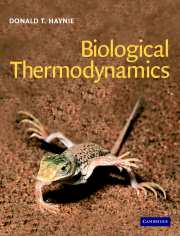Book contents
- Frontmatter
- Contents
- Preface
- Chapter 1 Energy transformation
- Chapter 2 The First Law of Thermodynamics
- Chapter 3 The Second Law of Thermodynamics
- Chapter 4 Gibbs free energy – theory
- Chapter 5 Gibbs free energy – applications
- Chapter 6 Statistical thermodynamics
- Chapter 7 Binding equilibria
- Chapter 8 Reaction kinetics
- Chapter 9 The frontier of biological thermodynamics
- Appendix A General references
- Appendix B Biocalorimetry
- Appendix C Useful tables
- Appendix D BASIC program for computing the intrinsic rate of amide hydrogen exchange from the backbone of a polypeptide
- Glossary
- Index of names
- Subject index
Chapter 3 - The Second Law of Thermodynamics
Published online by Cambridge University Press: 31 May 2010
- Frontmatter
- Contents
- Preface
- Chapter 1 Energy transformation
- Chapter 2 The First Law of Thermodynamics
- Chapter 3 The Second Law of Thermodynamics
- Chapter 4 Gibbs free energy – theory
- Chapter 5 Gibbs free energy – applications
- Chapter 6 Statistical thermodynamics
- Chapter 7 Binding equilibria
- Chapter 8 Reaction kinetics
- Chapter 9 The frontier of biological thermodynamics
- Appendix A General references
- Appendix B Biocalorimetry
- Appendix C Useful tables
- Appendix D BASIC program for computing the intrinsic rate of amide hydrogen exchange from the backbone of a polypeptide
- Glossary
- Index of names
- Subject index
Summary
Introduction
We have seen that a given amount of energy can be distributed in many different ways, just as a certain volume of fluid can adopt many different shapes and adapt itself to its container. In this chapter we shall learn about a thermodynamic function that enables us to measure how ‘widely’ a quantity of energy is distributed. The First Law of Thermodynamics relates heat, work and internal energy. It tells us that energy can neither be created nor destroyed, despite being able to change form; the total energy of a reaction, and indeed of the universe, is constant. The First Law tells us with breathtaking generality that a boundary on the possible is a basic characteristic of our universe.
It is not hard to see, though, that the First Law does not tell us other things we would like to know. For instance, if we put a hot system into contact with a cold one and allow them to come spontaneously to thermal equilibrium, we find that the final temperature of the two objects, which persists indefinitely if the objects are insulated, is at some intermediate value. ΔU, however, is 0. Similarly, if we mix a concentrated solution of substance A with a dilute solution of substance A, we find that the final concentration, which persists indefinitely, is between the initial concentrations (Fig. 3.1). Again, ΔU = 0. We conclude that unless ΔU = 0 implies spontaneity of reaction, the magnitude of ΔU probably does not indicate the direction of spontaneous change.
- Type
- Chapter
- Information
- Biological Thermodynamics , pp. 49 - 72Publisher: Cambridge University PressPrint publication year: 2001



